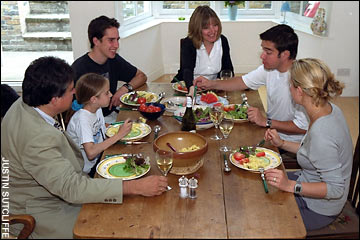The Good Book Company (Australia) will be closed from Saturday 21st December until Thursday 2nd January. Any orders placed during this time will be held and dispatched on Thursday 2nd January 2025. Emails will still be checked. Apologies for any inconvenience this causes.

Main point: Everyday evangelism is a job for everyone, not just for “professionals”
Evangelism is an intrinsic part of any healthy church. It’s part of gospel community. It shapes our gospel teaching. And perhaps it’s helpful to outline two potential approaches to evangelism a gospel-centered church can have: frog-centered, and lizard-centered.
Frogs are very good at catching flies with their long tongues. They stay on their lily pad, waiting for that fly to come close.
Lizards are not so good at catching flies. But they move around. They see more flies, and some they catch.
There may be a lot of biology-related holes in this analogy (if there are, blame the Lausanne Conference for World Evangelisation 1989—that seems to be where it was first used). But it’s a helpful way of thinking about evangelism (hopefully you won’t mind being described as a “frog” or a “lizard”!).
Could it be that often we (consciously or subconsciously) think of evangelism as a job for the pros, the people who work for the church? They’re great at explaining and defending the gospel—they have long tongues!
Problem is, the pros don’t get around that much. They’re not in the workplaces; not at the school gates; not in the sports clubs. That’s where the lizards, the ordinary church members, are. They come into contact with a lot more flies (non-Christians) than the professionals.
Every day, the church membership can be seeking to evangelise far, far more people than the church leadership ever can—particularly in a time when cultural reasons for contact with church leaders, such as baptisms and weddings, are fading.
So why don’t we? Maybe it’s because evangelism is seen as too hard, or too complicated. Or because we’ve tried it and “failed”. Or because we’ve simply never been challenged to do it. The obstacle to every-member evangelism will vary from church to church.
But the key is to empower and equip the lizards to go fly-hunting. A few ideas:
Practical suggestion: Ask yourself, or others, what stops them sharing the gospel. Then think about whole-church solutions to those obstacles.

Main point: Church is a place to be deliberately family-focussed and outsider friendly, at the same time.
Church is a family. Jesus Himself said “My mother and brothers are those who hear God’s word and put it into practice” (Luke 8 v 21).
But it’s an open family. Anyone can join, by receiving Jesus as Lord (John 1 v 12-13). And it’s a welcoming family. At the family get-togethers, what the family does is meant to attract outsiders (1 Corinthians 14 v 23-25).
Imagine the scene. It’s a suburban house, and the family are sitting down to their meal. Nothing special in that; but tonight is different. Johnny, the son, has brought his girlfriend, Sarah, round. It’s the first time his parents have met her—and the first time she’s met them.
How will the presence of Sarah make a difference? Well, in one sense, she won’t. The family is still the family, and she’s not part of it (yet—Johnny’s hopeful, though!). They still sit down at their dining table for food, at the normal time, in their normal places, eating food they like.
But in another sense, things are very different. Mum checked what food Sarah liked beforehand. Everyone introduced themselves to her. Dad made sure Sarah was included in the conversation. Her opinion was asked for and listened to.
Is this a helpful way to think about how our church gatherings should be? It’s a family occasion—with non-family members there. The family need feeding, but that never needs to be at the expense of being welcoming and accessible to non-Christians, listening to them and being relevant for them.
This isn’t an “either-or” (either church is for Christians, apart from the odd evangelistic service, or it’s a seeker service, for non-Christians, with nothing for mature believers). It’s a both-and (both for Christians and for newcomers).
I wonder if the way to tell if a church is both-and is this: Would church members confidently bring a non-Christian friend on any Sunday, and know that they’ll be welcomed, feel listened to, and hear the gospel relevantly?
What might help the answer to that question be “yes”? A few suggestions:
If Sarah chooses not to become part of the family, we want that to be because she decides she doesn’t love Johnny, not because his family put her off before she had a chance to work out how she felt about him! If a newcomer decides not to become part of our church family, let that be because they decide they don’t love the Lord Jesus—not because Jesus’ family put them off before they had the chance to work it out!
Practical suggestion: At your next Sunday service, try to put yourself in the shoes of someone who’s never been to church before. What would help you understand what was going on, feel included, and not awkward? What would help you feel valued and worthwhile, and as if you matter?

Main point: Gospel teaching and gospel community go hand in hand, and we need to be intentional about both.
The first Christian church was notable for two things: gospel teaching and gospel community. They “devoted themselves to the apostles’ teaching and to the fellowship” (Acts 2 v 42).
Through the gospel message, God saves us to be in community, a people. As Tim Chester and Steve Timmis put it in Total Church: “It is not that I belong to God and then make a decision to join a local church. My being in Christ means being in Christ with those others who are in Christ.”
We don’t just believe—we belong.
Which, Acts 2 shows, means:
This kind of loving, sharing, trusting, affirming community is what we were, literally made for. And yet belonging to a gospel community is counter-cultural. It doesn’t come naturally, because:
It seems to me there are lots of churches which are great at up-front gospel teaching—but wouldn’t be described as an Acts 2-type gospel community. Ironically, that actually undermines gospel teaching. Because it’s only in gospel community that gospel teaching becomes really effective—only there members can minister to one another, serve one another, encourage and rebuke one another.
Good church leaders don’t wait for gospel teaching to grow organically. They lead and model it from the pulpit, and they scaffold it through small-group Bible studies, encouraging people to use Bible-study notes, and so on.
Likewise, gospel community needs intentional building—requires leading, modelling, scaffolding. We can do church in a way that encourages and supports being together, sharing together, praising and witnessing together—being true community—or we can do church in a way which actually reinforces our natural individualistic consumerist tendencies.
Think about our churches.
Interestingly, in Acts 2, it’s not the gospel teaching so much as the gospel community which seems to have been noticed by those around the church. As Timmis and Chester write, “we have found some people wanting to be part of our church community not because they were interested in Christ, but because they wanted a kinder, gentler alternative to their existing network of relationships”.
Gospel teaching in gospel community is where we’ll see gospel growth. It’s worth being as intentional about planning and building community as we are about planning and preparing our teaching.
Practical suggestion: read Total Church. It’s one of those books that is both practical and provocative, and always thoroughly gospel-centred and gospel-hearted.

Main point: Service orders work best when they’re thoughtful, purposeful, and clear.
Service order. Not two words which set many hearts racing…
Some churches have a set order, which never changes. Some decide the order five minutes before the meeting begins each Sunday! Some change the order on the principle that variety is the spice of life.
But the order of the various elements in a Sunday meeting can both add greatly to, or detract from, a church family’s worship; and of their understanding of and response to the gospel teaching.
We’ve all seen parts of services which don’t really work. A song where no one knows why they’re singing it. The prayers after the sermon which don’t mention the teaching. The Communion which takes over half an hour to administer. Service orders need thinking about!
Two questions are helpful to ask of any part of the service: “Why are we doing this at this stage?” “Would someone in a pew/chair know why we are doing this at this stage?”
In other words, what is the purpose of each part of our time together?
Sometimes, neither gets asked. And often, if we’re honest, the service leader knows the answer to the first question, but no one else does!
If you’re taking this purposeful approach, at some stage in the week before the service, you need to list the various elements of your service—teaching, singing (including how often to sing, what to sing, and perhaps the “tone” in which it’s to be played), praying, notices, possibly Communion, perhaps a time to give financially. What will guide the order in which you write those elements down?
The single summary sentence of the teaching (see the post on gospel teaching) drives the service order. The beginning of the service recaps on the previous week, and/or introduces the theme, or the issue, or the question, that’s being spoken to by the Bible passage (and summed up in the sentence). The middle part teaches the summary sentence. And the last part applies it, enables people to respond to it, and/or reinforces it.
One week, the main teaching slot might be very early on, because there needs to be lots of time for discussion, prayer, thinking and application of what’s been said. Another week, the whole meeting might build up to the teaching, which therefore comes near the end—less time for considering application, but more for outlining the issues the passage addresses.
The summary sentence is the centerpiece of the meeting—virtually everything else in the meeting points to it in some way.
In a great book called “Worship by the Book”, where three pastors discuss how they order their gathered worship, Tim Keller (of Redeemer in New York) explains his three-part order to services.
i) Adoration
Christians arrive at church from a week in the world, where in some ways they’ll have forgotten who the real God is, and worshipped false gods. The first thing we need to do is to adore the true God, remembering and focusing and loving who He is.
ii) Renewal
This will lead us to see that we haven’t worshipped the true God in the past week. We need to renew our relationship with him, to seek and receive his forgiveness as His people.
iii) Commitment
Having renewed our grace-based relationship with the true God, we are ready to commit ourselves once more to his service, to consider how we will do that in the week ahead in His strength.
A time of confession and assurance of forgiveness slots into Part Two of the service—the rest can go pretty much anywhere. The teaching can be placed according to what the passage is. It can go early if it’s adoration-focussed, in the middle if it’s forgiveness-focussed, and towards the end if it’s more a call to action of some kind. But the whole service order leads the congregation through a narrative arc, from who they are when they enter (failing Christians who’ve forgotten God in some way) to who they are when they leave (forgiven Christians who’re leaving to serve God).
Those are just two possible approaches. Do add others that you’ve seen work well in the Comments below. There’s no “right way” of ordering a service. But being deliberate, thoughtful, and clear—answering both those “why” questions—will help avoid wrong ways.
Practical suggestion: Next Sunday, ask yourself the “why” questions after the service. And then scribble down how things would have been ordered according to the two approaches set out above.

The main point: Evangelicals are great at focusing on what we teach in church—we also need to think about how we teach.
How do evangelical churches do their teaching at Sunday meetings? Chances are, it’s done by one man, in one go.
And Scripture supports that method of teaching—there’s a lot of it in the Bible! But it’s not all there is in the Bible.
When Paul wrote to the Corinthian church, he thought it could be a good idea for “everybody” to prophesy (1 Corinthians 14 v 24). “Everyone” seemed to turn up with something to offer teaching-wise (v 26).
The Colossian church was told to make space for the gathering to “teach and admonish each other” (Colossians 3 v 16).
In Acts, Luke describes the way the apostles taught as “preaching” (eg: Acts 9 v 20)—and as interactive (2 v 36-39); “reasoned with” (18 v 4); “public debate” (v18 v 28); “discussions” (19 v 9); Bible study (17 v 11).
Should a block of up-front, top-down teaching be the only way Christians learn when they meet together as church?
Educational theory (as well as the Bible!) would suggest not. Of course, we don’t want to use secular research uncritically. But equally, we shouldn’t just write it off.
What to teach isn’t flexible: the unchanging truths of Scripture. But when it comes to how to teach, it’s helpful to bear in mind:
What implications might this have?
Of course, the what is more important than the how: but the how is still vital. We have many organizations, courses and conferences helping church leaders think about the what: is it time to begin to challenge ourselves and equip ourselves when it comes to the how?
Practical suggestion: Primary school teachers spend almost all of their prep time thinking through how to teach. Why not get a primary school teacher in your congregation… give them the main point of the passage for next week’s service… get them to imagine they’re teaching a lesson, only to adults… tell them to think imaginatively how they’d teach it… and see what they come up with!

This is the first in a series of blog posts on “Church outside the box”. It’s aim is to prompt discussion, to raise questions, and to offer a few ideas. It’s the product of thinking-in-progress, so when you think of something to add, or want to raise a question or disagreement, please use the Comment box!
The main point: As we do church, we need to be inflexible on the inflexibles, but also flexible on the flexibles.
Imagine sitting down with a Bible in your left hand, and a blank sheet of paper in your right. Then imagine writing down on the right-hand piece of paper everything your left-hand Bible says MUST happen at your church meetings.
What would be on it? I think the list would pretty much look like this:
That’s not a very long list! It’s worth mentioning what it doesn’t include:
In your right hand is a bit of paper with a lot of room left. A lot of space to imagine, or re-imagine, how our church gatherings look, feel and run. A lot of areas to be flexible, to think about what will most encourage our fellow Christians, and what will most connect with our community’s non-believers.
An individual church exists in a culture, a time, a place. Two of those three are always changing. If a church isn’t flexible on non-Biblical essentials, it will be existing in (and seeking to reach) a culture that no longer exists, in a time which has passed. Surely it’s no accident that that Bible leaves us so much flexibility.
In our left hand is the Bible. No room left at all here—it’s packed with everything God wants us to know about His Son. This is what we need to be resolutely inflexible on—it is what our fellow Christians, and our communities’ non-believers, need to hear.
A church needs to be inflexible on what the Bible says, for the glory of God… and flexible on everything else—for the glory of God.
This may seem obvious! But is it how our churches work? Let’s categorise churches into four types:
Type One
Type Two
Type Three
Type Four
Is it worth asking what type of church our own is? And if it’s not Type Four, asking what would need to change to make it that kind of church?
Practical suggestion: Actually get that right-hand sheet of paper. Scribble down what the Bible says we MUST do in church. Then use the space that’s left to re-imagine church, for your culture and community, which: